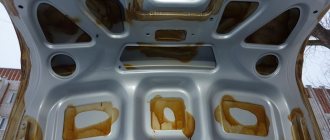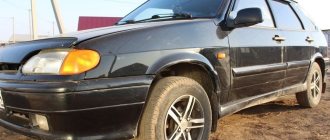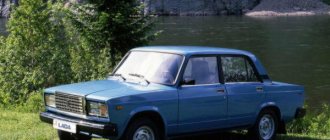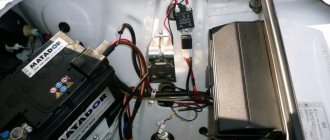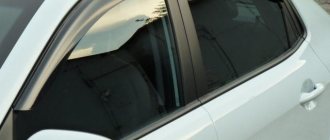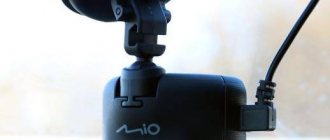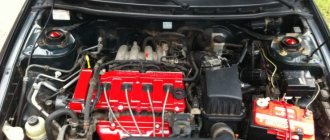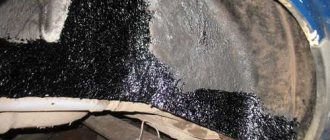DIY anticorrosive will save money and protect the car body from corrosion. There are many recipes for this remedy, and their use will depend on the place of treatment. There are two main types of anticorrosive - mastic and oil. The first one protects the surface well, but has low penetrating ability. They do anti-corrosion treatment on the bottom and arches. Oil anticorrosives have great penetrating ability, so it can flow into various cracks and hollows, thereby making the anticorrosive into hidden cavities.
What are anti-corrosion agents for cars?
To make a car anticorrosive yourself, you need to clearly understand for what purposes this product will be intended. Modern anti-corrosion agents are divided into two main types - highly penetrating (oil-based) and barrier (mastic). There are also wax and bitumen, but this classification is not based on physical parameters, but on composition. Therefore, the best anticorrosion agents are those that are optimally suited for specific tasks.
By definition, in the body of a new car, just released from the assembly line, there are no pockets of corrosion. Therefore, metal surfaces there are treated with barrier (mastic) anti-corrosion agents. Their validity period is on average 3...5 years (for premium cars or more). If the anticorrosive treatment is not repeated, then after 10 years the body will need to be repaired.
Most cars that have been in use for more than five years have rust in the hidden cavities of the body, including under the paintwork. In such cases, the car is treated with oil anticorrosives with high penetrating ability. Their function is to penetrate to the source of rust and displace moisture there. However, it is necessary to understand that the validity of such funds is usually no more than one year. After this, the anti-corrosion treatment begins to crack and moisture gets in there again.
Re-treatment with an oil-type anti-corrosion agent is recommended to be renewed every year. In some cases, after applying an oil anti-corrosion agent, a barrier-type anti-corrosion agent is applied on top of it. However, this technique can only be done on relatively old car bodies.
Why does the bottom need to be treated?
Moisture falling on an unprotected metal surface gradually destroys it. Over time, holes of different sizes appear on the bottom. Accordingly, the strength of the body decreases, which inevitably leads to defects and malfunctions.
Ignoring the “symptoms” will lead to the spread of corrosion to “healthy” areas. Over time, the chassis, shock absorbers and suspension will suffer its destructive effects.
By the way, corrosion also forms in the presence of minor damage. They, in turn, appear from regular off-road driving. You also need to understand that there is such a thing as “metal fatigue”. With continuous use of the car, the metal is “depleted”, so it is more easily susceptible to oxidation.
The “blow” from all these negative aspects is taken by the protective layer. If it is missing, then the machine will quickly “fall into disrepair.”
How to make anticorrosive yourself
There are many different recipes for making both oil and mastic anticorrosives. Let's separate the recipes into two separate sections.
Mastic anti-corrosion agents
Means for making anticorrosive:
- some rubber bitumen, preferably automotive, mastic in the amount of three kilograms;
- 150...200 grams of auto plasticine;
- cannon fat, 200...300 grams;
- solvent, white spirit or similar product;
- iron containers for preparing mastic;
- gas or fuel burner (you can take a blowtorch);
- a rubber spatula or other tool for applying the product to the surface to be treated.
Algorithm for manufacturing an anti-corrosion agent:
- place three kilograms of mastic in an iron pan and use a burner to heat it to a liquid state;
- add plasticine and cannon fat to the mastic, then bring the resulting mass to a boil;
- depending on how liquid the mastic should be, you can add a solvent and stir it (for example, if the mastic needs to be applied to hard-to-reach places or hidden cavities and so that it spreads there).
The entire procedure can be done exclusively outdoors or in a well-ventilated area, taking fire safety precautions and using personal protective equipment (gloves, goggles and a respirator)!
Judging by the reviews of car enthusiasts who have used such products, such an anticorrosive agent creates a thick protective layer on the treated surface that perfectly resists not only moisture, but also gravel. Can be used at any time of the year.
Oil-based anti-corrosion agents
Oil-based anti-corrosion agents are, firstly, the cheapest, and secondly, they are not so demanding on the presence of rust on the surface being treated. Allows you to protect metal from water and ultraviolet radiation. True, their disadvantages include the relative short duration of action.
Anticorrosive for hidden surfaces
The first recipe . Nigrol is added to the Movil product (a traditional product for treating hidden surfaces of car body parts) in a ratio of approximately 5 to 1. After this, the resulting product must be diluted with white spirit to the desired consistency (depending on the required fluidity of the product).
Recipe two . Take two parts Movil, one part nigrol and one volume part cannon fat. All this must be mixed in a metal container and brought to a boil. It is necessary to treat the surface of the car body, firstly, in the warm season (at a temperature not lower than +20°C), and secondly, the product itself must be fluid. Experience shows that the specified anticorrosive agent is very durable (up to 10...15 years of reliable body treatment).
Recipe three . One of the simplest remedies is to mix equal amounts of Movil, nigrol and cannon lard. With the help of such an anti-corrosion composition, they usually treat not only the bottom, but also the sills of the car, including from the inside, pouring it there using a mobilizer.
Recipe four . Mix five liters of diesel fuel, 3 kilograms of gun fat, two liters of Movil. If necessary (if it is not liquid enough), you can add a little additive in the form of some kind of solvent. The product is well suited for treating various internal surfaces and lasts a long time.
Anticorrosive for the underbody and wheel arches of the car
The first recipe . You need to take 3 kilograms of bitumen mastic and about 0.5 liters of used motor oil, and then mix them. After this, add more gasoline to the resulting solution and stir thoroughly again. The result should be a composition similar to sour cream. Please note that this composition is applied in three layers. And each subsequent layer is applied only after the previous one has completely dried. To speed up drying, you can use a hair dryer or simply put the car in a warm box.
Recipe two . The composition is suitable for treating the underbody and wheel arches. Apply to a washed, thoroughly sanded and degreased surface! You need to apply anti-gravel and let it dry. Next, after this, you need to apply one or two layers of Movil lubricant.
Recipe three . The following product can be applied even to the surface where there is a small (!!!) amount of rust and can be used to treat hidden cavities. So, to make it you will need:
- 700 grams of cannon fat;
- 2.5 kilograms of solid oil;
- about 700 g of used machine oil;
- about 1.5 kg of construction bitumen;
- a 5...6 liter bucket and a gas or other burner for heating.
How to make anticorrosive for the bottom, sills and wheel arches:
- pour the used oil into the pan and heat it up a little;
- then add solid oil and bitumen there, and let them melt a little over the fire;
- add cannon fat, mix well, bring to a boil.
Before application, the surfaces to be treated are always washed well. A small amount of rust and grease on the surface is acceptable (but not desirable). Before application, the composition needs to be heated slightly.
The disadvantage of this product is that almost the entire time it is active it is in an oily state . Therefore, if you have to crawl under the bottom of the car, there is a high probability of getting your clothes dirty. But it protects well, has a long service life and does not fly off over time.
Recipe four . You need to take two three-kilogram cans of bitumen-rubber mastic (or in other packaging, but of the same weight), and dilute it portionwise in gasoline. The resulting mastic should have the consistency of water. This will be the material for the first layer of processing. It is applied with a brush. The second is similar, mastic in gasoline, but with the consistency of gravitex, that is, thicker. It is advisable to apply this material using a gravitex spray gun. The third layer is similar to the second. Judging by the reviews of car enthusiasts, such treatment of the bottom, sills and arches lasts at least 5...6 years, or even more. The main thing is that the surface is well washed and degreased.
Treatment of the underbody, sills and wheels of a car must be carried out every 3...4 years for a new car, as well as when purchasing a used car, or in case of mechanical damage. And the sooner you do this, the better!
Cannon fat
Many car enthusiasts use so-called cannon lard, a preservative lubricant based on thickened petroleum oil, to treat the bottom and wheel arches of a car. It contains an anti-corrosion additive. Temperature range of use is from –50°С to +50°С. Before applying cannon lard, it must be heated to a liquid state.
Please note that when working with cannon fat, you need to take precautions - do not allow it to come into contact with your skin and especially your eyes, and if it falls on the floor, remove it and treat the damaged area with sand.
Cannon lard has excellent adhesive properties, is not afraid of moisture, and adheres well to inclined surfaces. However, since gun lard is precisely a preservative lubricant , its service life on constantly moving machines can be significantly reduced. It is for this reason that many car enthusiasts add various mastics, solvents and other compounds to it, thereby diluting it.
ML oils
Under this name are hidden products called preservatives for hidden cavities, analogues of Movil, but with their own advantages. Unlike Movil, ML oils have greater fluidity, they do not clog drainage holes, do not form clots, and also protect metal surfaces much better from corrosion. Thus, if Movil is best applied to flat surfaces, then ML oils can be used for inclined and hidden surfaces, including those where there is rust (but without dust and dirt). On open surfaces, ML oils can withstand up to 20...30 thousand kilometers, and on hidden surfaces - up to 50 thousand or more.
An example of such a product is Kerry Hidden Surface Preservative ML. It is sold in aerosol cans.
Types of processing
Many drivers do not know what kind of treatment for the underbody of a car against corrosion, what is the best way to carry it out? There are a lot of protective products available today, so you need to choose them wisely and responsibly. For example, some formulations include “heavy” elements. But such products greatly harm paintwork materials. Do not forget that the main goal of the product is reliable and uniform protection of weak areas of the bottom. In addition to the bottom, other body elements (welding points, wheel arches) are also treated with compounds.
In addition to the fact that the composition should not contain aggressive components, it can also be water-repellent. You can enhance the protection with the help of anti-gravel. Manufacturers also suggest trying compounds based on rubber and silicone.
Plastic
Liquid plastic is a polymer mixture. You can make it yourself or purchase it in a store. This composition is compatible with almost all surfaces. It does not lay down another layer on the metal, but is combined with it into one whole.
After applying liquid plastic, it fills every chip and crack of the car. Now moisture and dirt will not penetrate the metal of the vehicle, and, accordingly, corrosion will not form.
Bitumen-based mastic
Bitumen mastics, compared to rubber mastics, reliably protect the bottom of the car. However, this composition does not dry completely, so it always remains soft. Unfortunately, this feature does not provide complete protection against mechanical damage.
Bitumen mastics contain synthetic oils. These substances protect the body from moisture and oxygen. When applying, the main thing is not to overdo it. For reliable protection, a layer of 0.4 mm is sufficient.
PVC rubber materials
PVC rubber materials are products created in the form of a suspension. In addition to polyvinyl chloride, the composition contains stabilizers, pigments and amplifiers. The product itself is quite durable, so drivers use it more often than others.
Oil formulations
Oil formulations are presented in liquid form. The fluidity allows the product to penetrate into all the bumps and cracks on the body. In addition, cannon lard is popular. This is a thickened oil with special additives. It reliably protects the metal from oxidation, since it contains a large amount of paraffin. The only thing that oil does not provide is protection from damage. The driver should repeat the treatment regularly.
How to apply anticorrosive to a car body
After you have made your own anti-corrosive coating for a car, you can also make a mobilizer yourself - a device for applying anti-corrosive coating to hard-to-reach places. This is especially true for pouring an anti-corrosion agent into the thresholds of a car to treat their internal surfaces. So, for this you will need:
- a used (fully discharged) powder fire extinguisher with a volume of about two kilograms, always with a working shut-off device;
- a rubber hose about two to three meters long, that is, so that its length is enough to process the thresholds of a particular car, the diameter is the same as the outlet of a fire extinguisher, and at the end of the hose there should be side holes for spraying liquid;
- epoxy resin;
- a new car nipple with threads so that it can be screwed into a metal surface;
- Movil for processing thresholds and, possibly, other car body parts.
How to make a fire extinguisher yourself from a decommissioned fire extinguisher, the algorithm is as follows:
- unscrew the locking device from the body of the fire extinguisher;
- insert a flexible hose into the outlet of the fire extinguisher and fix it from the inside with epoxy resin, then wait a day to allow the epoxy to fix well;
- drill a hole in the upper part of the fire extinguisher body of such a diameter that you can insert and tighten the nipple;
- cut a thread on the hole and screw the nipple into it so that excess pressure can be created in the cylinder with a compressor.
To operate the fire extinguisher, it is necessary to pour a certain amount of anti-corrosion agent into it (the volume depends on the work to be done and the design of the thresholds), and then pump air into the fire extinguisher cylinder with a compressor to 2...4 atmospheres (depending on the design of the fire extinguisher, its volume, the volume of the thresholds, and so on) . After this, stretch the hose into the inner cavity of the thresholds to the end. Next, press the release lever of the fire extinguisher, after which spraying will begin from the hose inside the threshold. After this, you need to pull the hose back, thereby gradually filling the internal cavity of the thresholds. It is necessary to fill until anticorrosive agent flows out of the technological holes.
And in order for the anti-corrosion treatment of a car with your own hands to be of high quality, it is not enough to use good materials, it is also important to adhere to the application technology, and for this you need to properly prepare the surface - remove paint, clean with a brush, treat with a corrosion inhibitor, degrease.
Corrosion and its varieties
Metal corrosion, as has already become clear, occurs for various reasons. That is why it is divided into types. Let's look at each of them.
Chemical - formed due to the interaction of metal with a corrosive environment.
Continuous - captures the metal in a completely continuous layer.
Local - originates over the entire metal surface and appears in the form of spots.
Crevice - appears in body gaps, as well as in threads and under gaskets.
In fact, there are even more varieties identified. For example, the electrochemical type of corrosion manifests itself in the same way as the chemical one. However, this creates an electric current in the system. Drivers also mention selective and intergranular rust. The first one destroys one part of the metal, and the second one appears in places where there were previously marks from impacts.
DIY car anticorrosive
Now that you have the means and tools for the job in your hands, you can treat the car body with anti-corrosion agent yourself.
Before applying any anti-corrosion agents, the surfaces to be treated must be thoroughly washed with shampoo, areas of rust must be removed, sanded thoroughly, it is advisable to use a converter and degrease. And after that, treat with a primer - primer. This will enable the product to reliably protect the surface.
Do-it-yourself anticorrosive treatment of a car in some cases will differ, since the features of the body and the goals facing the car enthusiast may differ. It is advisable to process the bottom and wheel arches with the machine suspended or installed on an inspection pit. The general case of treating a car with an anticorrosive agent that has rust is performed according to the following algorithm :
- Provide access to the surface to be treated. If we are talking about the bottom and wheel arches, then it is necessary to raise the car, free the arches from sound insulation, dismantle mud flaps, fender liners, protective covers, or remove plugs from the drainage holes.
- Clean the accessible surface from rust using sandpaper, a brush or a grinder with a cleaning wheel.
- Wash with shampoo those areas of the car body that are subsequently supposed to be treated with an anti-corrosion agent. If possible, it is advisable to force-dry the treated surfaces.
- If the treatment will be carried out from a spray bottle, then it is necessary to protect the sensors and electrical connectors with film.
- Using a brush, spray bottle or spray gun, apply anticorrosive agent to the surfaces to be treated.
- Typically, anti-corrosion agents are applied in 2…4 layers. Before applying the next layer, you need to wait until the previous one has dried.
If you want to treat a car whose paintwork is still intact, then simply wash and dry.
Advantages of ready-made formulations
Anti-corrosion products sold in car stores have special advantages over those made by yourself. Firstly, the compositions are immediately ready for use. There is no need to make them and spend time on it. Secondly, before application the driver does not need to prepare the surface in any way. Thirdly, the substances contain a lot of additional components that have auxiliary properties.
In addition, ready-made anticorrosives can be applied in any weather. The operating range varies from -30° to +50°C. The driver will not need to renew the coverage. Damaged metal is restored as quickly as possible. To apply the composition you do not need to have special skills. This is done quite simply according to the instructions.
Carrying out rust removal work
Anti-corrosion cleaning of the underbody of the car should be carried out only after washing, since this way you can see all the problem areas. After drying the body, you should begin examining the surface to identify pockets of rust or swollen paint.
The next stage of work is to clean the affected area. Cleaning time directly depends on the method used to remove the old layer of mastic. So, the most time-consuming and tedious method is cleaning with a wire brush or sandpaper. Using a grinding machine, you can prepare the surface for further work much faster.
Important: you need to clean the area 3-4 cm around the rust stain until a smooth and even surface appears.
After the cleaning work is completed, you need to treat the problem area with a degreasing solution and apply a rust converter. Its main task is to transform the rust remaining on the bottom into soil. It is applied using a regular rag. After waiting for the corrosion converter to dry, you can apply a new layer of anti-corrosion coating.
Processing methods
Each method of processing the bottom has its own characteristics. But it all comes down to the fact that the driver just needs to apply a protective layer to the metal and that’s it. Let's look at 3 main methods and outline their specifics.
Active
As for the active method, the substance Movil is used for its implementation. Today it is really popular among car enthusiasts. This is due to the fact that Movil protects the metal from the influence of the atmosphere. In addition, it contains an inhibitor. This component fights rust that has already appeared. Special additives, which are also present in the composition, prevent moisture from penetrating the metal.
Movil has excellent contact with other types of mastic. That is why there is no need to remove the old coating before applying it. In combination with another layer, Movil becomes dense, which provides even more reliable protection.
When treating the bottom with Movil, the driver needs to be careful. The substance can destroy any rubber products. Before the procedure, you should remove them from the work area.
Passive
The passive method involves applying various types of mastics. They usually contain bitumen. However, there are products containing rubber or resin. In the store, these products can be found under the names: “bitumen mastic” or “epoxy anticorrosive”.
Before applying mastic, it is necessary to clean the surface to be treated. It is worth applying primer to the bottom. To make the mastic liquid, it is recommended to heat it.
The surface is treated with anticorrosive in several layers. Thanks to this, the metal ceases to come into contact with the environment, which means that corrosion does not form. In addition, a dense mastic layer increases sound insulation properties.
Transformative
A transformative treatment method will be needed if the driver missed the beginning of rust formation. In this situation, you need to purchase products that can convert corrosion into a protective layer. These products contain phosphoric acid.
Automotive stores offer a wide selection of domestic and imported products. For example, “Tsinkar” and “Kolchuga” convert corrosion into a zinc-phosphate layer. After applying these anticorrosives, additional treatment using Movil will be required.
Processing stages
The processing procedure is carried out gradually. To avoid mistakes, you must follow the instructions. It is applicable for work using any anti-corrosion agents.
Step-by-step instructions for the procedure:
1. First of all, you need to clean the bottom from traces of dust and dirt. Some owners simply rinse the surface with water, others thoroughly clean all layers with a hard brush. If the driver wants to get the most excellent effect, he should use the services of a car wash.
2. It is not recommended to apply compounds to a wet surface. That is why after washing it is worth drying the bottom with hot air.
3. After drying the metal, the driver does not need to immediately begin the procedure. First, you should inspect the bottom and identify damage, chips and other defects. If upon inspection small pockets of corrosion are found, they should be removed.
4. Now you can begin the application itself. This is best done with a silent sprayer. With its help, it is easier to treat the entire surface, while covering it with an even layer. Hard-to-reach areas are covered using a gun with nozzles.
For the processing operation to be successful, you should leave the car for at least a day in a garage or under some kind of canopy. The procedure should take place outdoors in a place where there are no open sources of fire.
Before using this or that product, you should read the instructions. Some products require longer drying time.
Cannon fat
Separately, it is worth noting the so-called “cannon fat”. This protective composition is a thickened oil containing anti-corrosion additives, designed specifically to protect the vehicle's metal from oxidation. Solid “cannon fat”, which is used for the bottom, contains a lot of paraffin. Soft is used for processing inside cavities. This product has proven itself to be a good anticorrosive agent. It adheres well to the surface and is not washed off with water. However, “cannon fat” does not provide mechanical protection and requires periodic renewal.
